In the digital age, libraries are evolving beyond simple repositories of books. They are becoming dynamic, technology-driven spaces that deliver efficiency for staff and convenience for patrons. One of the most transformative tools behind this shift is the RFID library management system. Unlike bar codes, which require manual scanning, RFID technology utilises wireless communication to identify, track, and secure library assets quickly and accurately.This blog provides an in-depth look at what an RFID library management system is, the benefits it offers, the associated costs, and the steps required to set it up effectively.
What is an RFID Library Management System?

An RFID library management system uses Radio Frequency Identification (RFID) tags attached to books, journals, or multimedia resources. Each tag contains a microchip with a unique identifier. RFID readers, installed at self-checkout kiosks, security gates, or handheld devices, capture data from these tags without requiring line-of-sight contact.The system integrates with a Library Management System (LMS) to update circulation status, manage inventories, and provide security alerts. Libraries typically use passive High Frequency (HF) tags, operating at 13.56 MHz, as they offer reliability, low cost, and durability for thousands of scans across an item’s lifetime.
How Does RFID library management system works ?
The functionality of an RFID library management system can be broken into four steps:
- Tagging: Every item in the collection is embedded with or attached to an RFID tag.
- Reading: RFID antennas and readers detect tags wirelessly when a patron checks out or returns items.
- Data Processing: Middleware translates the tag’s ID into meaningful data and communicates with the LMS.
- Updates & Alerts: The LMS updates the record (e.g., book checked out to Patron A) and, if necessary, security gates flag unauthorised removals.
This seamless process eliminates the need for manual scanning, reduces errors, and supports bulk operations.
Key Benefits of RFID library management in Library Science

Implementing an RFID library management system creates measurable value for both library staff and patrons:
1. Faster Circulation
With RFID, patrons can check out multiple books simultaneously at self-service kiosks. This reduces queues, speeds up circulation, and gives staff more time to engage in community programming.
2. Efficient Inventory Control
Handheld RFID scanners allow librarians to conduct shelf inventories rapidly. Staff can simply walk along the stacks while the device automatically detects books on the shelves. This converts multi-day barcode inventories into tasks that take hours.
3. Improved Security
RFID-enabled security gates can detect items that haven’t been checked out properly. This helps minimise losses and protects valuable collections without requiring additional personnel.
4. Better Resource Utilisation
By automating circulation and inventory tasks, libraries and rapid radio solutions free up staff hours for higher-value work like user engagement, collection development, and educational events.
5. Enhanced User Experience
Patrons benefit from quicker transactions, better availability of books (since inventories are more accurate), and easier returns.
Costs of RFID library management Implementation
The cost of an RFID library management system depends on library size, collection volume, and level of automation. Below are the main components to budget for:
- RFID Tags: Each item requires a tag. In bulk, costs typically range between 0.05 and 0.50 per tag.
- Readers & Antennas: Self-checkout kiosks, gate sensors, and handheld readers form the hardware backbone. A basic setup can cost several thousand dollars per unit.
- Middleware & Software Integration: Software that connects RFID readers with your LMS may come as a one-time license fee or a recurring subscription.
- Installation & Tagging Labour: The physical process of tagging thousands of items can take weeks or months, depending on collection size.
- Overall Project Costs: RFID vendors in India may spend between 5,000 and 15,000. Larger institutions with tens of thousands of items can see investments ranging from 20,000 to over 1 lakh.
While the upfront investment is significant, most libraries recover costs within a few years thanks to efficiency gains and reduced losses.
Setting Up an RFID System
Rolling out an RFID library management system requires careful planning. Here is a structured approach:
1. Assess Needs
Evaluate the size of your collection, number of patrons, and pain points with current systems. Are you looking for faster circulation, theft prevention, or better inventory control?
2. Choose Standards-Based Tags
Select ISO 28560-compliant RFID tags to ensure interoperability between vendors and future-proofing against system changes.
3. Pilot Project
Tag a small subset of books and test the system with self-checkout, return, and gate security. This reveals potential integration issues early.
4. Integration with LMS
Work with vendors to ensure RFID middleware communicates seamlessly with your Library Management System using standard protocols like SIP2 or NCIP.
5. Full Rollout
Once tested, tag the full collection. Install gates, self-check kiosks, and handheld readers. Train staff to use and troubleshoot the system.
6. Maintenance & Review
Periodically audit tags for wear, recalibrate readers, and update middleware to maintain performance.
Challenges to Consider
While the benefits are significant, libraries should be aware of potential challenges:
- Tag Durability: Poor-quality tags may fail, especially on heavily used books.
- Initial Tagging Effort: Large collections require significant labour during implementation.
- Cost Barrier: Smaller community libraries may find the initial investment challenging.
- System Integration: Some legacy LMS platforms may need customisation for RFID compatibility.
Planning ahead helps mitigate these challenges.
Future of RFID library management in Libraries
The RFID library management system is not just about faster checkouts. It paves the way for advanced features: automated return sorting systems, integration with mobile apps for real-time item location, and data analytics for smarter collection development. With IoT and AI integration, RFID-enabled libraries will become even more interactive, data-driven, and user-friendly.
FAQs
Is an RFID library management system better than barcodes?
Yes. RFID enables bulk scanning, faster checkouts, and accurate inventory management. Barcodes require line-of-sight scanning of individual items.
How long do RFID library management tags last?
High-quality RFID tags can last several years, often outliving the physical lifespan of books themselves.
Can RFID library management stop theft entirely?
It significantly reduces theft but should be combined with policies and periodic audits. No system is 100% foolproof.
How often should the system be maintained?
Routine maintenance includes checking tags, updating middleware, and testing gate sensitivity every 6–12 months.







